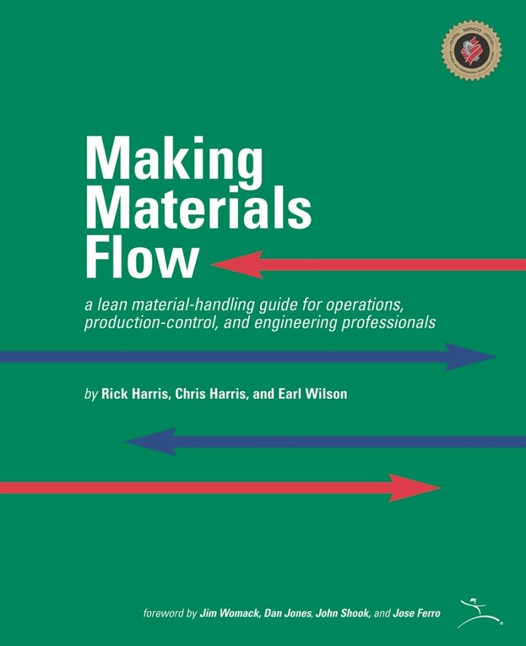


Making Materials Flow explains in plain language how to create such a system by applying the relevant concepts and methods in a step-by-step progression. The workbook reveals the exercises, formulas, standards, and forms that a consultant would use to implement the system in your environment. And, like LEI's other workbooks, Making Materials Flow answers the key question managers often have about lean manufacturing tools and concepts, "What do I do on Monday morning to implement this?"
The four key steps detailed in the workbook include:
1.) Developing the Plan For Every Part (PFEP). This basic database fosters accurate and controlled inventory reduction and is the foundation for the continuous improvement of a facility's material-handling system.
2.) Building the purchased-parts market. Learn the formulas and methods to size and operate a market that eliminates the waste of hoarding, searching for parts, and storing inventory throughout a facility.
3.) Designing delivery routes. You get the principles and calculations that turn a sprawling, messy plant into an organized community where operators get the parts they need, when needed, and in the quantity needed, delivered right to their fingertips. Proper delivery routes not only improve inventory and flow but also safety and housekeeping.
4.) Implementing pull signals to integrate the new material-handling system with the information management system. Learn the steps to creating a system that keeps inventory under control by allowing operators to pull just what they need while focusing on producing value for customers. You'll also learn how to calculate the number of pull signals needed and how often to deliver material.
Finally, you'll learn how to sustain and continuously improving the system by implementing periodic audits of the material-handling system across the chain of management, from route operator to plant manager. You'll learn the five-step process for introducing audits of the market, routes, and pull signals by a cross-functional team from production control, operations, and industrial engineering.
Harris and co-authors Chris Harris and Earl Wilson lead you through 10 simple but pragmatic questions that show how a lean manufacturing facility implements a robust but flexible lean material-handling system for purchased parts:
The Plan For Every Part (PFEP)
1. What information should you include in the PFEP?
2. How will you maintain the integrity of the PFEP?
Developing a Purchased-Parts Market
3. Where do you locate your purchased-parts market?
4. What is the correct size for your purchased-parts market, and what is the correct amount of each part to hold in the market?
5. How do you operate your purchased-parts market?
Designing the Delivery Route and the Information Management System
6. How do you convey parts from the purchased-parts market to the production areas?
7. How do your production areas signal the purchased-parts market what to deliver and when?
8. How do you fill the delivery route?
Sustaining and Improving
9. How can you sustain the performance of your lean material-handling system?
10. How can you identify and remove additional waste?
An appendix explores how to adapt the key principles of lean material-handling to more complex environments, such as incorporating work-in-process (WIP) markets into the system for purchased parts, adding delivery routes from production cells to a finished-goods market, and applying the system to low-volume, high-mix processes.
Making Materials Flow will benefit lean leaders, managers, and executives in production control, operations, and engineering who have at least a basic knowledge of lean concepts such as value-stream mapping, cell design, and standard work. The 93-page workbook contains more than 50 illustrations.
ISBN# 0974182494
Authors: Rick Harris, Chris Harris, and Earl Wilson
Pages: 93
Binding: Paperback
Item#: 70B7025

